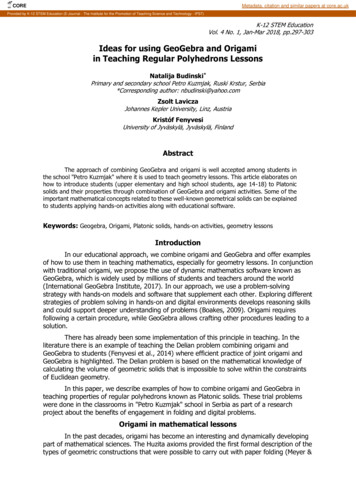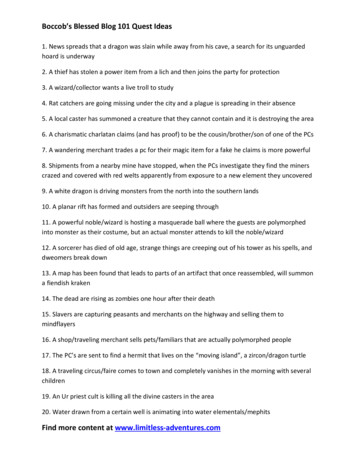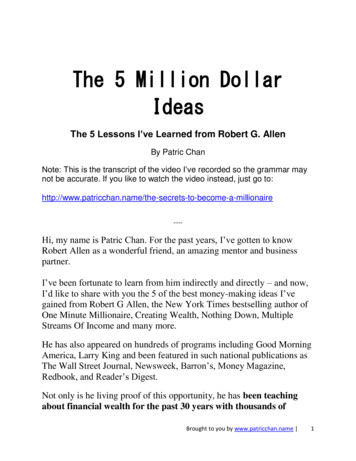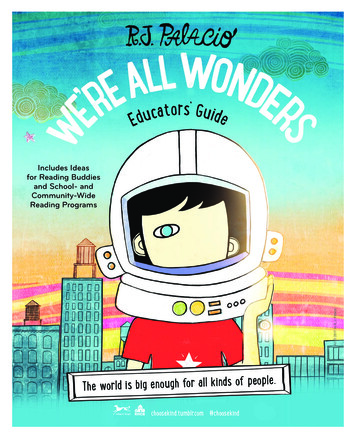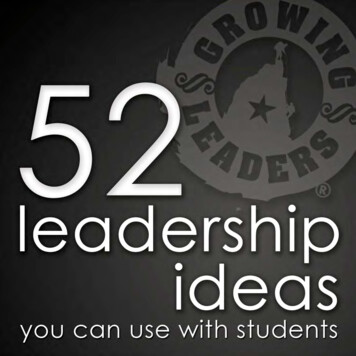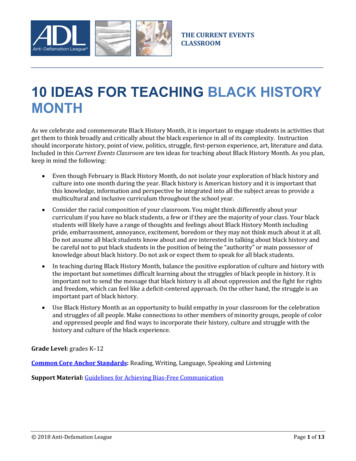
Transcription
THE CURRENT EVENTSCLASSROOM10 IDEAS FOR TEACHING BLACK HISTORYMONTHAs we celebrate and commemorate Black History Month, it is important to engage students in activities thatget them to think broadly and critically about the black experience in all of its complexity. Instructionshould incorporate history, point of view, politics, struggle, first-person experience, art, literature and data.Included in this Current Events Classroom are ten ideas for teaching about Black History Month. As you plan,keep in mind the following: Even though February is Black History Month, do not isolate your exploration of black history andculture into one month during the year. Black history is American history and it is important thatthis knowledge, information and perspective be integrated into all the subject areas to provide amulticultural and inclusive curriculum throughout the school year. Consider the racial composition of your classroom. You might think differently about yourcurriculum if you have no black students, a few or if they are the majority of your class. Your blackstudents will likely have a range of thoughts and feelings about Black History Month includingpride, embarrassment, annoyance, excitement, boredom or they may not think much about it at all.Do not assume all black students know about and are interested in talking about black history andbe careful not to put black students in the position of being the “authority” or main possessor ofknowledge about black history. Do not ask or expect them to speak for all black students. In teaching during Black History Month, balance the positive exploration of culture and history withthe important but sometimes difficult learning about the struggles of black people in history. It isimportant not to send the message that black history is all about oppression and the fight for rightsand freedom, which can feel like a deficit-centered approach. On the other hand, the struggle is animportant part of black history. Use Black History Month as an opportunity to build empathy in your classroom for the celebrationand struggles of all people. Make connections to other members of minority groups, people of colorand oppressed people and find ways to incorporate their history, culture and struggle with thehistory and culture of the black experience.Grade Level: grades K–12Common Core Anchor Standards: Reading, Writing, Language, Speaking and ListeningSupport Material: Guidelines for Achieving Bias-Free Communication 2018 Anti-Defamation LeaguePage 1 of 13
The Current Events Classroomadl.org/lesson-plans1 READ AND DISCUSS BLACK LITERATURE1. Have students read and discuss black literature by exploring different genres including: fiction, nonfiction, speeches, poetry, plays, spoken word and short stories. Be sure to include the classics as well ascontemporary books that include African American, Afro Caribbean and African voices.2. Read and discuss the literature as a whole class or create small group book clubs where each club readsa different book or collection together. Some general questions to guide literature discussions include: What is the book/poem/story about? What is the theme, meaning and message of the book/poem/story? How are the characters developed? What is the main conflict and how is it resolved? What did you most like about the book? What did like least about it? What does the book/poem/story reflect about the black experience?3. Have small group book clubs discuss what they read and undertake a group project such as: Write book reviews (and the class can create a blog of all the book reviews). Act out a scene from a play they read. Use the genre that they read to write their own poems, short stories, plays or beginnings of a novel. Learn more about the author and compile and summarize book reviews. Create a drawing or collage that illustrates their favorite or most important part or scene.Other whole class ideas: Attend a poetry reading or poetry slam in your area. Go to a book reading and hear an author read their book aloud. Have students read to younger children either in their school or in a neighboring school. This couldserve as a springboard for a “book buddies” program throughout the school year.RESOURCESWebsitesBlack History: Featured Poems (Poets.org)10 African-American Authors Everyone Should Read (Forbes Magazine, February 18, 2012)Popular Black History Month Books (Goodreads.com)African American Fiction Writers: A Selected List (The Public Library of Cincinnati and Hamilton County)Celebrating Black History Month: Poems, Articles and Podcasts (Poetry Foundation)ADL Booklists for Elementary Students Ages 0–12Racism titlesSlavery titles 2018 Anti-Defamation LeaguePage 2 of 13
The Current Events Classroomadl.org/lesson-plans2 IDENTIFY AND INVESTIGATE IMPORTANT PERIODS IN BLACK HISTORY1. Have students identify and learn about important periods in Black history which may include The Middle Passage Great Migration Slavery in America Harlem Renaissance Civil War andReconstruction Jim Crow SegregationEra Abolition Civil Rights Movement Post-Civil RightsMovement Modern Times2. Working alone, with a partner or in small groups, have students study one of the time periods. Afterconducting research, students can undertake one or more of the following projects to demonstratetheir learning: Create mini-timelines for the time period. Provide biographical information about important people during that time period. Draw or paint portraits of important people and events and write a placard that goes along with theportrait. Create a mini-documentary about the time period. Write and perform a skit demonstrating something about the time period. As a class, create a complete Black History timeline, using all of the mini timelines from each group.RESOURCESWebsitesBlack History Month and Black History Milestones (The History Channel, history.com)Timeline: Key Moments in Black History and Black History Month Activities, History, Timeline, Ideas,Events, Facts & Quizzes (Fact Monster)The African Americans: Many Rivers to Cross (PBS.org)ADL Curriculum Resources on the Civil Rights MovementMartin Luther King, Jr. and Civil Rights: Relevancy for TodayThe Life and Achievements of Rosa ParksLooking Back Reaching Forward: Exploring the Promise of Brown v. Board of Education 50 Years LaterShirley Chisholm: Unbought, Unbossed and UnforgottenThe Civil Rights Act of 1964: 7 Ways to Commemorate the 50th Anniversary 2018 Anti-Defamation LeaguePage 3 of 13
The Current Events Classroomadl.org/lesson-plans3 EXPLORE BLACK ARTExplore Black artists and art by visiting online galleries as well as museums in your area that focus on orcontain a collection of black or African American art. Have students think broadly about different types ofart including photography, painting, sculpture, architecture, drawing, craft/folk art as well as “street art”including graffiti and murals. Some suggested activities are: As a class, visit a black, African American or African art museum. Give students some backgroundinformation prior to the museum trip and provide activities and items to look for as they arewalking around the museum. Have students go to the museum on their own or with their family and discuss what they saw as aclass after everyone has visited the museum or exhibit. Have students select a time period and look at Black art over that that time period, writing a criticalanalysis of the art and also creating some of their own art that reflects that time period. Have students delve deeper into one specific artist. Some artists include: Jean-Michel Basquiat,Jacob Lawrence, Gordon Parks, Faith Ringgold, Romare Bearden, Augusta Christine Savage, WilliamHenry Johnson and Kara Walker. Students can also conduct research to discover other artists. Havethe students learn about the artists’ life, their motivation, their style, their message, the time periodin which they were artists and then have students create some their own art in the same style astheir selected artist.WEBSITES ABOUT ART, ARTISTS AND MUSEUMSSmithsonian’s National Museum of African American History and CultureAssociation of African American MuseumsList of Museums focused on African Americans (Wikipedia)Ask Art: The Artists’ Bluebook4 LEARN ABOUT IMPORTANT PEOPLE IN BLACK HISTORY1. Have students identify and study important people in Black history. The process of identifying peoplewill be a learning experience as will the actual research. Begin with categories such as: artists spiritual leaders musicians political activists business people inventors writersathletes andentertainers2. Using these categories, have students brainstorm names of people they might know or have heard ofwho are important people in Black history. After brainstorming, have students go home and interviewtheir parents, family members and friends, asking them for additional names. Instruct students to bringthose names to school to add to the list.3. Next, have students conduct library and internet research to find more names. A good resource to useduring this discovery period is HBO’s The Black List: Volume 1, 2, and 3 as well as some of the websitesin Idea 2. This is all part of the learning process. After compiling a long list of names within each 2018 Anti-Defamation LeaguePage 4 of 13
The Current Events Classroomadl.org/lesson-planscategory, have students pick a person they want to learn more about. Try to discourage the majority ofyour students from choosing sports and entertainment figures, which young people are sometimesoverly drawn towards. Encourage students to choose people from history as well as contemporarypeople. For each of the people they research, give students various options for presenting what theylearned about the person they studied. Their learning should culminate in a project about the personsuch as: Write and perform a short skit about the person. Write diary entries from their person’s point of view. Create a portrait of the person. Write a short biography. Create a sculpture of the person, using clay, plaster of paris or found objects. Write an original speech that the person might give. Create a timeline of their life. Make a webpage about them, using photos and original written material.5 WATCH AND DISCUSS FILMS ABOUT THE BLACK EXPERIENCEThroughout the years, there have been a wide range of films made about the black experience, somedirected by Black directors and some not. Some films to consider are listed below. For reviews andinformation about age level appropriateness, check Common Sense Media.Pre–1970:The Jackie Robinson Story (1950), Native Son (1951), Carmen Jones (1954), Porgy and Bess(1959), A Raisin in the Sun (1961), Nothing But A Man (1964)1970s:Sparkle (1976), Lady Sings the Blues (1972), The Autobiography of Miss Jane Pittman(1974), Roots (1977), Killer of Sheep (1977), The Wiz (1978)1980s:Soldier’s Story (1984), The Color Purple (1985), Native Son (1986), Hollywood Shuffle(1987), School Daze (1988), Lean on Me (1989), Glory (1989), Do the Right Thing (1989)1990s:To Sleep with Anger (1990), House Party (1990), New Jack City (1991), Daughters of theDust (1991), Boys N the Hood (1991), The Five Heartbeats (1991), Malcolm X (1992),Poetic Justice (1993), Crooklyn (1994), The Tuskegee Airmen (1995), Get on the Bus (1996),Eve’s Bayou (1997)2000–present: Love and Basketball (2000), Ali (2001), Barbershop (2002), Drumline (2002), AntoineFisher (2002), Ray (2004), When the Levees Broke (2006), A Raisin in the Sun (2008),Pariah (2011), Django Unchained (2012), 42 (2013), The Butler (2013), 12 Years a Slave(2013), Belle (2013), Mandela: Long Walk to Freedom (2013), Get On Up (2014), Selma(2014), 13th (2016), Barry (2016), Birth of a Nation (2016), Hidden Figures (2016),Moonlight (2016), Southside with You (2016), Get Out (2017), Marshall (2017), Mudbound(2017) 2018 Anti-Defamation LeaguePage 5 of 13
The Current Events Classroomadl.org/lesson-plansStudents can explore, watch and learn about black films in the following ways: Organize a black film festival for the school. Create a program and a schedule and show filmsthroughout the month of February and beyond. Have students work in small groups and preview films by decades, having each small group take adecade between the 1960s and current day. Have each small group watch at least 2–3 films fromthat time period to discuss together and present to the group. For each week in February, choose a different film for all the students to watch (either in class orindependently) and discuss. In addition to discussion questions particular to each film, here aresome general questions you can ask about any of the films: What is the point of view of the film? How did the director portray the “black experience?” Are the characters complex, stereotyped or a combination? What did you learn about the Black experience from the film? For its time period when the film was made, was it ahead (or behind) of its time in terms of itsportrayal of Black people? How did the director develop the characters? What is the director trying to show about time and place? Did you like the film? Why or why not?Have students choose one film to focus on to learn more about the context of the film and thedirector. Instruct them to (1) read reviews about the film, (2) gain background knowledge aboutthe time period portrayed, (3) research more about the director and her or his point of view and (4)write an analysis of the film with their own review.6 LISTEN TO BLACK MUSIC1. Learn about the historical significance of music developed for and by African Americans over the yearsincluding blues, jazz, gospel, spirituals/work songs, 1950s rock and roll, 1960s Motown, disco, soul andhip hop.2. As a class, listen to all the different genres of music and ask students questions such as: How did it make you feel while listening? What instruments did you hear? What is the meaning of the lyrics What other music do you think was influenced by it?3. Have students work individually or in small groups to learn more about one genre of music, its history,how it was developed and famous artists in that genre. Small group projects can include: Pick a decade in history and in addition to the music of that time period, research its significance topolitics and culture, the social justice context of the music and the genre’s influence on dance andclothing styles. 2018 Anti-Defamation LeaguePage 6 of 13
The Current Events Classroomadl.org/lesson-plans Create a short documentary about one of the genres of music. Select a genre of music and compile a playlist of songs for the class to listen to. After listening to themusic, the students will lead a discussion about the music: what instruments were played, meaningof the lyrics, similarities and differences to other genres of music, etc. Interview their parents and adult family members, teachers and other adults about the music thatthey like, specifically asking what their connection is to any of the genres of music listed above.WEBSITES ABOUT MUSICA Brief History of the Blues (All About Jazz.com, August 16, 2005)History of Jazz (Scholastic, teacher.scholastic.com)Jazz: A History of America’s Music (PBS.org)Classic Motown (classic.motown.com)A History of Gospel Music (NPR.org)The History of Hip-Hop: 1925–Present (About.com)Negro Spirituals History (NegroSpirituals.com)7 LEARN ABOUT BLACK MIGRATION AND IMMIGRATION1. Learn more about and analyze black immigration and migration patterns in United States historyincluding the: Great Migration, which was the migration of six million African Americans from the rural South tothe urban Northeast, Midwest and West that lasted until the 1960s. Recent new immigration patterns of black people from the Caribbean and Africa and The New Great Migration, which is the demographic changes from 1965 to the present whichreflects a reverse of the Great Migration, where Black people are moving back to Southern states,particularly Georgia, North Carolina, Virginia, Tennessee, Florida and Texas.2. Either individually or in small groups, have students study these different migration and immigrationperiods in history and work on the following projects: Analyze the reason for the patterns of migration and immigration during that time period,culminating in a written analysis. Review census data, collect and analyze statistics and create graphs and infographics whichillustrate the immigration and migration patterns. Conduct oral histories about these immigration and migration patterns by interviewing people whoimmigrated or migrated during these periods or have family members who did.WEBSITESGreat Migration: The African-American Exodus North (NPR.org)The Great Migration (In Motion: The African-American Migration Experience, inmotionaame.org)The New Great Migration: Black Americans’ Return to the South, 1965–2000 (The Brookings Institution,May 2004) 2018 Anti-Defamation LeaguePage 7 of 13
The Current Events Classroomadl.org/lesson-plans“The Great Reverse Migration: African-Americans are abandoning the Northern cities that have failedthem” (Pittsburgh Post-Gazette, September 30, 2012)A Demographic Profile of Black Caribbean Immigrants in the United States (Migration Policy Institute)African Immigrants in the United States (Migration Policy Institute, July 2011)8 CLASSIFY AND TAKE ACTION ON THE CIVIL RIGHTS ISSUES OF OUR TIMES1. Starting with students’ knowledge of the civil rights movement of the 1950s and 1960s, identifyimportant civil rights issues of today for black people. Have students brainstorm possible issuesincluding: “school to prison pipeline,” disproportionate rates of black incarceration, re-segregation ofthe school system, housing and employment discrimination, weakening of affirmative action, economicissues (such as minimum wage and the cost of higher education) that impact black mobility, racialdisproportionality in “stop and frisk” procedures, police officer-involved deaths of men of color, votingrights, racial profiling and hate crimes.2. After brainstorming, have students decide which present day civil rights issue they want to investigatefurther. In pairs or small groups, students can research their chosen topics and develop the followingprojects to demonstrate what they learned: Develop a social media campaign to raise awareness. Write and perform a skit. Create an infographic on one of the issues in order to educate the public. Engage in a service learning project that addresses the issue. Write letters to the editors of local and national newspaper about the issue. Get involved in local social action efforts. Conduct a survey to find out what others think about it. Create a PSA (public service announcement).9 TALK ABOUT RACISM AND DISCRIMINATION1. While we do not want to focus exclusively on racism and discrimination during Black History Month,these are important aspects of the black experience and it is critical to address. Talk with your studentsabout the history of racism in the United States from slavery to Jim Crow to current day forms ofdiscrimination and racism (see Idea 8).2. Engage students in interactive activities to help them learn about and distinguish between individual,institutional and internalized forms of racism and oppression. Develop a common language and avocabulary for talking with students about these issues.3. Make the connection between racism and other isms and forms of discrimination such as classism,sexism, religious discrimination, homophobia, ableism, immigration discrimination, languagediscrimination and provide the context of the Pyramid of Hate.4. Have students share their own experiences with discrimination and be sure to help them understandthe societal institutions and systems which support and reinforce racism. Use art, literature, film and 2018 Anti-Defamation LeaguePage 8 of 13
The Current Events Classroomadl.org/lesson-planshistory to explore these issues in a deeper way. Always provide information about how people workedtogether to fight racism and make fundamental change.5. Learn more about ADL’s educational programs on Anti-Bias Education and our Curriculum Resourcesthat focus on racism and racial diversity.10 RESEARCH THE ORIGINS OF BLACK HISTORY MONTH1. Find out how and why Black History Month was created, why February was chosen and what theannual theme for Black History Month is this year as well as past years.2. Have students find different ways to share this information with other students in the school and thecommunity at large by writing articles, making posters, using social media or creating a website orTumblr about it.3. In pairs or small groups, have students do the following projects: Research different points of view about the pros and cons of Black History Month and similarly—themed months. Read essays with multiple perspectives and have students share their ownviewpoints in writing, citing evidence and quotes from the tests they read. Design and conduct a survey with teachers in the school asking them if they intend to teach aboutBlack History Month and how. Find out what events and activities in their town or neighborhood will be happening tocommemorate Black History Month. Share this information with the rest of the school community.Create a calendar to share. As a culminating project for the month of study, create a word cloud using the words and conceptsfrom all the student projects. Publish this on the school’s website. 2018 Anti-Defamation LeaguePage 9 of 13
The Current Events Classroomadl.org/lesson-plansCOMMON CORE ANCHOR STANDARDSContent Area/StandardReadingStandard 1: Read closely to determine what the text says explicitly and to make logical inferences from it;cite specific textual evidence when writing or speaking to support conclusions drawn from the text.Standard 2: Determine central ideas or themes of a text and analyze their development; summarize thekey supporting details and ideas.Standard 4: Interpret words and phrases as they are used in a text, including determining technical,connotative, and figurative meanings, and analyze how specific word choices shape meaning or tone.Standard 6: Assess how point of view or purpose shapes the content and style of a text.Standard 9: Analyze how two or more texts address similar themes or topics in order to build knowledgeor to compare the approaches the authors take.WritingStandard 1: Write arguments to support claims in an analysis of substantive topics or texts using validreasoning and relevant and sufficient evidence.Standard 2: Write informative/explanatory texts to examine and convey complex ideas and informationclearly and accurately through the effective selection, organization, and analysis of content.Standard 4: Produce clear and coherent writing in which the development, organization, and style areappropriate to task, purpose, and audience.Standard 6: Use technology, including the Internet, to produce and publish writing and to interact andcollaborate with others.LanguageStandard 3: Apply knowledge of language to understand how language functions in different contexts, tomake effective choices for meaning or style, and to comprehend more fully when reading or listening.Standard 4: Determine or clarify the meaning of unknown and multiple-meaning words and phrases byusing context clues, analyzing meaningful word parts, and consulting general and specialized referencematerials, as appropriate.Standard 5: Demonstrate understanding of figurative language, word relationships, and nuances in wordmeanings.Speaking and ListeningStandard 1: Prepare for and participate effectively in a range of conversations and collaborations withdiverse partners, building on others’ ideas and expressing their own clearly and persuasively.Standard 2: Integrate and evaluate information presented in diverse media and formats, including 2018 Anti-Defamation LeaguePage 10 of 13
The Current Events Classroomadl.org/lesson-plansvisually, quantitatively, and orally.Standard 4: Present information, findings, and supporting evidence such that listeners can follow the lineof reasoning and the organization, development, and style are appropriate to task, purpose, andaudience.Standard 5: Make strategic use of digital media and visual displays of data to express information andenhance understanding of presentations. 2018 Anti-Defamation LeaguePage 11 of 13
The Current Events Classroomadl.org/lesson-plansGUIDELINES FOR ACHIEVING BIAS-FREECOMMUNICATION1. Be aware of words, images and situations that suggest that all or most members of a group arethe same. Stereotypes often lead to assumptions that are unsupportable and offensive.Example: The writer who describes Mexican children as “well-dressed” may be unconsciouslyportraying this as an exception to a mental image of a “poor” or “unkempt” Mexican.2. Avoid qualifiers that reinforce stereotypes. A qualifier is added information that suggests what isbeing said is an exception to what is expected.Examples: “A group of intelligent black students were guests as part of the orientation program.” Ahelpful test is to consider whether a member of the majority population is likely to be described in thesame way; i.e. “the intelligent white students.”3. Identify people by identity characteristics only when relevant. Very few situations require suchidentification.Example: If this identification is inappropriate, “Michael Bloomberg, noted heterosexual mayor of NewYork,” is this phrasing any different: “twenty-two House Democrats, led by gay DemocraticRepresentative Barney Frank ?”4. Be aware of language that, to some people, has questionable racial or ethnic connotations. Whilea word or phrase may not be personally offensive to you, it may be to others.Examples: Culturally deprived or culturally disadvantaged. These terms imply superiority of one cultureover another. In fact, people so labeled are often bicultural and bilingual. Non-white – this word impliesthat white is the standard. In North American language, similar phrases such as “non-black” or “nonyellow” do not exist. Minority – this word is accurate in North America; however, its use ignores the factthat people of color comprise the majority of the world’s population (and may comprise the majority ofone’s immediate locale).5. Be aware of the possible negative implications of color symbolic words. Choose language andusage that do not offend people or reinforce bias. In some instances, black and yellow have becomeassociated with the undesirable or negative.Examples: “black reputation” and “yellow coward”6. Avoid patronizing language and tokenism toward any racial or ethnic group.Example: Once-a-year articles or special editions about a particular group may be interpreted ascultural tokenism, especially when such a group constitutes a large part of your community. Thisapproach may suggest that that racial or ethnic group is out of the mainstream.7. Substitute substantive information for ethnic clichés. Don’t let ethnic clichés substitute for in-depthinformation.Example: A person of Spanish heritage might prefer to be asked about family history or politicalexperiences than about fiestas. 2018 Anti-Defamation LeaguePage 12 of 13
The Current Events Classroomadl.org/lesson-plans8. Review media to see if all groups are fairly represented.Examples: Are persons portrayed in positions of authority almost invariably white? Does your mediaprovide racial and ethnic role models?Adapted with permission from Without Bias: A Guidebook for Nondiscriminatory Communication, Second Edition withpermission from John Wiley & Sons, Inc. 1982 2018 Anti-Defamation LeaguePage 13 of 13
10 IDEAS FOR TEACHING BLACK HISTORY MONTH . Write book reviews (and the class can create a blog of all the book reviews). . art including photography, painting, sculpture, architecture, drawing, craft/folk art as well as “street art” incl
